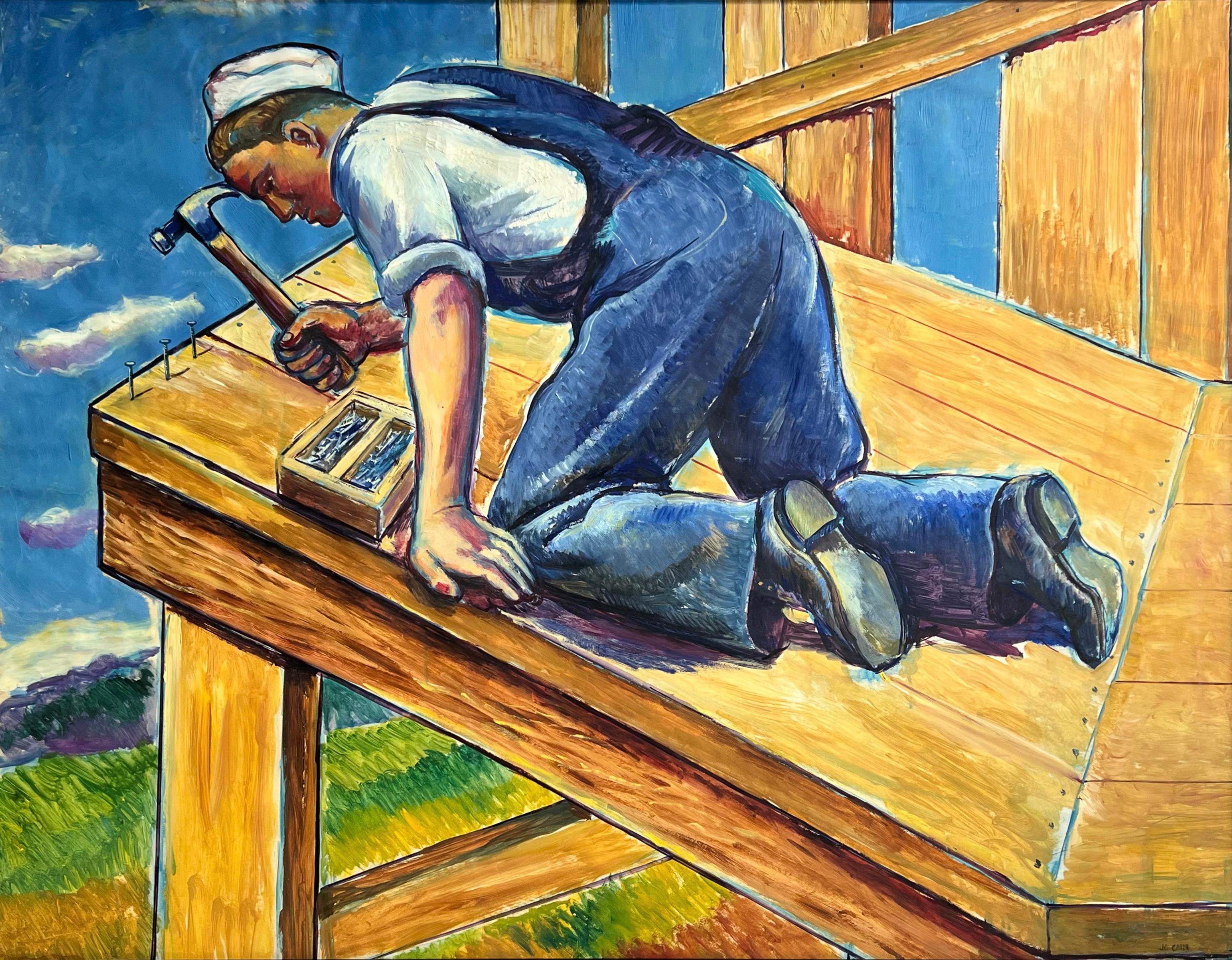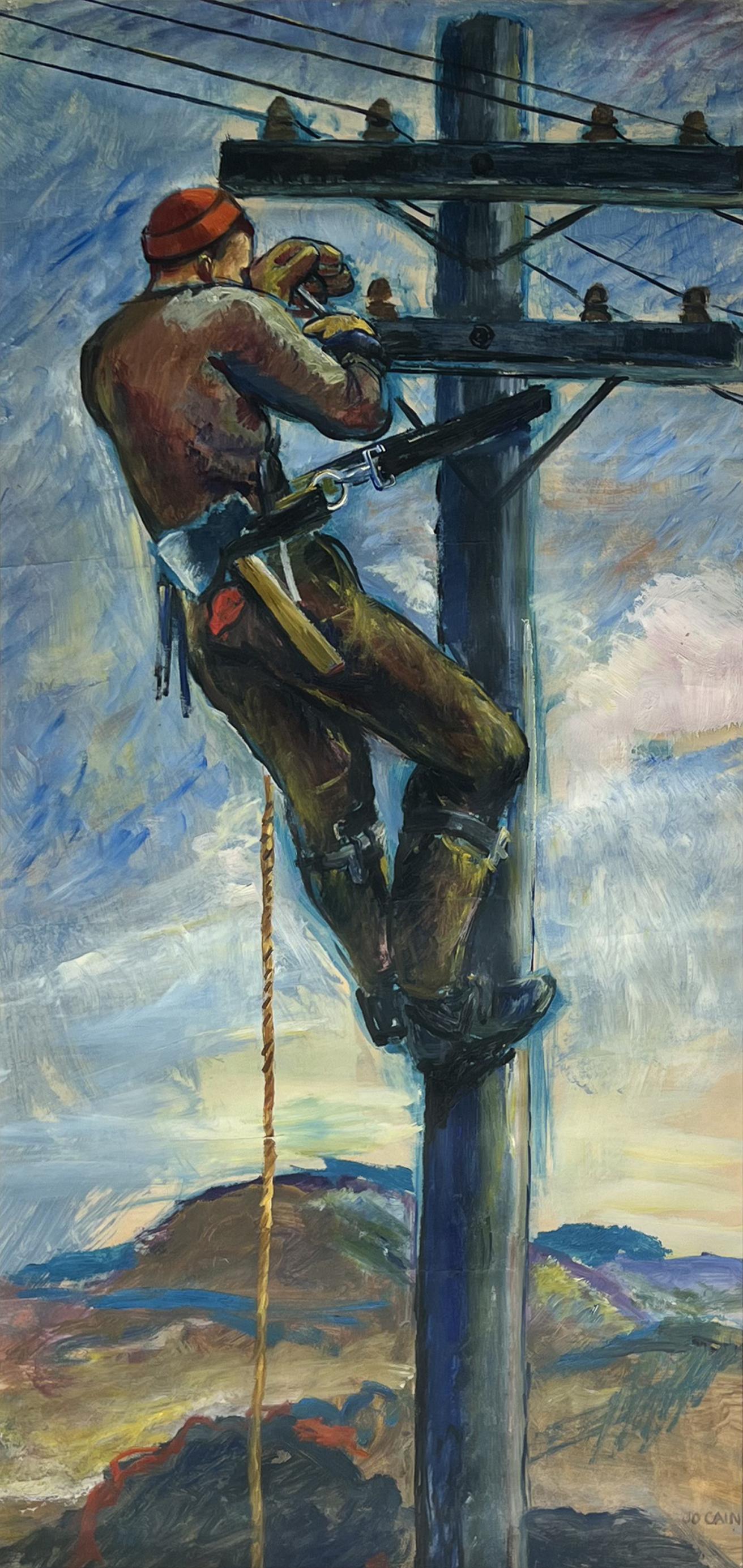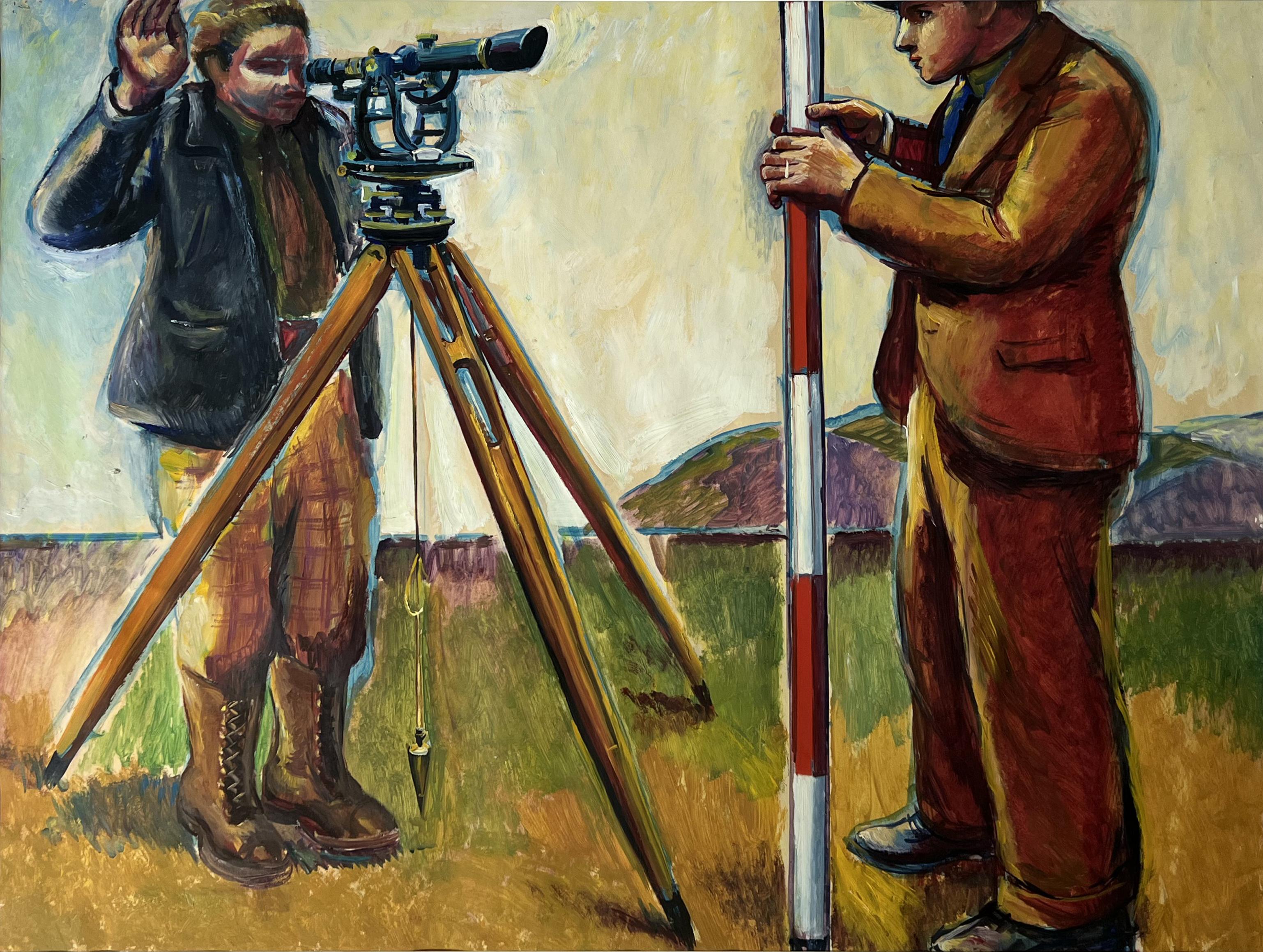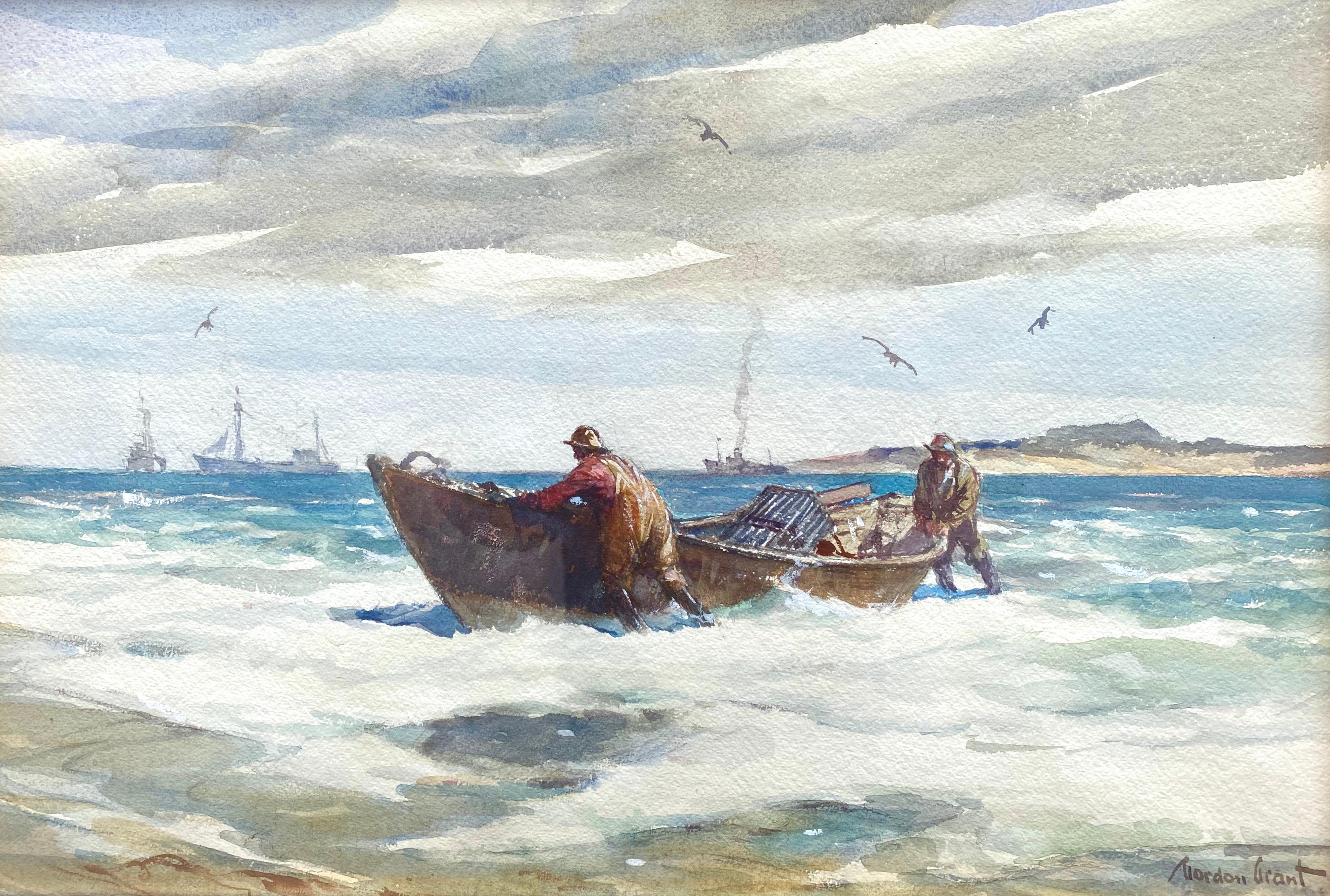Items Similar to Pot Creek, NM, Late Summer
Want more images or videos?
Request additional images or videos from the seller
1 of 4
Jane K. StarksPot Creek, NM, Late Summer2012
2012
About the Item
Jane Starks immerses herself in the history and archaeology of the places she loves to paint: wilderness areas of Texas, New Mexico, and Utah. The paintings are begun and completed on site, without photographs or preliminary sketches, in the media of gouache (opaque watercolor) and watercolor. About her work, Jane Starks states:
"Wilderness as well as pockets of wilderness in urban areas draw me in. Through these paintings I want to capture empirically, not romantically, the truth of what I see and how I see it. They are specific to the season and time of day, as well as terrain and vegetation. I wish to deepen as well as heighten the sensations created by looking at a painting, to pull the viewer more intimately into the picture plane, and to create paintings that achieve a striking optical immediacy and reveal a supple painterly navigation between representation and abstraction—sense and nonsense. Illusion, the vehicle of painting, is a powerful lens to reality. I hope my paintings serve as a record of the solitude and beauty of the diminishing wilderness under our domain."
Although Jane Starks was reared in California, her adult years were spent in Dallas where she raised two children. An MFA from SMU in 1999 followed degrees in archaeology from California State University at Long Beach and a Master of Science in Community and Regional Planning in the School of Architecture at The University of Texas at Austin.
This works well as a trio with "Pot Creek, New Mexico, Summer," 2011, and "Pot Creek, New Mexico, Autumn," 2011.
The paper size is 44 x 30 inches. The price does not include a frame.
- Creator:Jane K. Starks (1951, American)
- Creation Year:2012
- Dimensions:Height: 41.13 in (104.48 cm)Width: 27.25 in (69.22 cm)
- Medium:
- Movement & Style:
- Period:
- Condition:
- Gallery Location:Dallas, TX
- Reference Number:
About the Seller
5.0
Recognized Seller
These prestigious sellers are industry leaders and represent the highest echelon for item quality and design.
Established in 1954
1stDibs seller since 2013
151 sales on 1stDibs
Typical response time: A week
Associations
Art Dealers Association of America
- ShippingRetrieving quote...Ships From: Dallas, TX
- Return PolicyA return for this item may be initiated within 2 days of delivery.
More From This SellerView All
- East Fork Frio River, WinterBy Jane K. StarksLocated in Dallas, TXJane Starks immerses herself in the history and archaeology of the places she loves to paint: wilderness areas of Texas, New Mexico, and Utah. The paintings are begun and completed o...Category
Early 2000s Realist Drawings and Watercolor Paintings
MaterialsPaper, Gouache
- Fort Burgwin, NM, SpringBy Jane K. StarksLocated in Dallas, TXJane Starks immerses herself in the history and archaeology of the places she loves to paint: wilderness areas of Texas, New Mexico, and Utah. The paintings are begun and completed o...Category
2010s Realist Landscape Drawings and Watercolors
MaterialsPaper, Gouache
- Pot Creek, NM, SummerBy Jane K. StarksLocated in Dallas, TXThe paper size is 30 1/8 x 44 inchesCategory
21st Century and Contemporary Contemporary Landscape Drawings and Waterc...
MaterialsGouache, Paper
- Mytoge Mountain Road, Utah, SummerBy Jane K. StarksLocated in Dallas, TXJane Starks immerses herself in the history and archaeology of the places she loves to paint: wilderness areas of Texas, New Mexico, and Utah. The paintings are begun and completed o...Category
2010s Contemporary Landscape Drawings and Watercolors
MaterialsGouache, Paper
- Pot Creek, New Mexico, SummerBy Jane K. StarksLocated in Dallas, TXJane Starks immerses herself in the history and archaeology of the places she loves to paint: wilderness areas of Texas, New Mexico, and Utah. The paintings are begun and completed o...Category
2010s Contemporary Landscape Drawings and Watercolors
MaterialsGouache, Paper
- Boats at the DockBy Stephen Seymour ThomasLocated in Dallas, TXgouache with pen and ink signed "Seymour Thomas" at lower rightCategory
20th Century Academic Landscape Drawings and Watercolors
MaterialsGouache, Pen, Ink
You May Also Like
- Industrial Man Working Mid 20th Century American Scene Social Realism Modern WPABy Jo CainLocated in New York, NYIndustrial Man Working Mid 20th Century American Scene Social Realism Modern WPA Jo Cain (1904 - 2003) Hammering Nails 39 x 50 ½ inches Gouache on paper c. 19...Category
1930s American Realist Figurative Drawings and Watercolors
MaterialsPaper, Gouache
- Man Working Mid 20th Century American Scene Social Realism Industrial WPA ModernBy Jo CainLocated in New York, NYMan Working Mid 20th Century American Scene Social Realism Industrial WPA Modern Jo Cain (1904 - 2003) Telephone Pole Worker 38 1/4 x 18 1/2 inches Oil on pap...Category
1930s American Realist Figurative Drawings and Watercolors
MaterialsPaper, Gouache
- Surveyors WPA American Scene Mid 20th Century Modern Social Realism Men WorkingBy Jo CainLocated in New York, NYSurveyors WPA American Scene Mid 20th Century Modern Social Realism Men Working Jo Cain (1904 - 2003) Surveyors 30 ½ x 40 ¼ inches (sight) Gouache on paper c. 1930s Signed lower rig...Category
1930s American Realist Figurative Drawings and Watercolors
MaterialsGouache, Paper
- “The Lobstermen”By Gordon GrantLocated in Southampton, NYBeautiful original watercolor and gouache on archival paper by the famous American marine artist, Gordon Grant. The artwork depicts two rugged lobstermen bringing their catch ashore...Category
1930s American Realist Landscape Drawings and Watercolors
MaterialsWatercolor, Gouache, Archival Paper
- Edam, HollandBy Thomas FransioliLocated in New York, NYThomas Fransioli’s cityscapes are crisp and tidy. Buildings stand in bold outline, their forms squarely defined by stark light and long shadows. Saturated color permeates every corner of his canvases, from vibrant oranges and greens to smoky terra cottas and granites. Even the trees that line Fransioli’s streets, parks, and squares are sharp and angular, exactly like those in an architect’s elevation rendering. But Fransioli’s cities often lack one critical feature: people. His streets are largely deserted, save for parked cars and an occasional black cat scurrying across the pavement. People make rare appearances in Fransioli’s compositions, and never does the entropy of a crowd overwhelm their prevailing sense of order and precision. People are implied in a Fransioli painting, but their physical presence would detract from the scene’s bleak and surreal beauty. Magic Realism neatly characterizes Fransioli’s artistic viewpoint. The term was first broadly applied to contemporary American art in the 1943 Museum of Modern Art exhibition, American Realists and Magic Realists. As exhibition curator Dorothy Miller noted in her foreword to the catalogue, Magic Realism was a “widespread but not yet generally recognized trend in contemporary American art…. It is limited, in the main, to pictures of sharp focus and precise representation, whether the subject has been observed in the outer world—realism, or contrived by the imagination—magic realism.” In his introductory essay, Lincoln Kirstein took the concept a step further: “Magic realists try to convince us that extraordinary things are possible simply by painting them as if they existed.” This is Fransioli, in a nutshell. His cityscapes exist in time and space, but certainly not in the manner in which he portrays them. Fransioli—and other Magic Realists of his time—was also the heir to Precisionism, spawned from Cubism and Futurism after the Great War and popularized in the 1920s and early 1930s. While Fransioli may not have aspired to celebrate the Machine Age, heavy industry, and skyscrapers in the same manner as Charles Sheeler, his compositions tap into the same rigid gridwork of the urban landscape that was first codified by the Precisionists. During the 1950s, Fransioli was represented by the progressive Margaret Brown...Category
20th Century American Realist Landscape Drawings and Watercolors
MaterialsPaper, Gouache
- Passaic Falls in New JerseyBy Nicolino V. CalyoLocated in New York, NYNicolino Calyo's career reflects a restless spirit of enterprise and adventure. Descended in the line of the Viscontes di Calyo of Calabria, the artist was the son of a Neapolitan army officer. (For a brief biographical sketch of the artist see Philadelphia Museum of Art, Pennsylvania, Philadelphia: Three Centuries of American Art, exhib. cat. [1976], pp. 299-301 no. 257.) Calyo received formal training in art at the Naples Academy. His career took shape amidst the backdrop of the political turbulence of early nineteenth-century Italy, Spain, and France. He fled Naples after choosing the losing side in struggles of 1820-21, and, by 1829, was part of a community of Italian exiles in Malta. This was the keynote of a peripatetic life that saw the artist travel through Europe, to America, to Europe again, and back to America. Paradoxically, Calyo’s stock-in-trade was close observation of people and places, meticulously rendered in the precise topographical tradition of his fellow countrymen, the eighteenth-century vedute painters Antonio Canale (called Canaletto) and Francesco Guardi. In search of artistic opportunity and in pursuit of a living, Calyo left Malta, and, by 1834, was in Baltimore, Maryland. He advertised his skills in the April 16, 1835 edition of the Baltimore American, offering "remarkable views executed from drawings taken on the spot by himself, . . . in which no pains or any resource of his art has been neglected, to render them accurate in every particular" (as quoted in The Art Gallery and The Gallery of the School of Architecture, University of Maryland, College Park, 350 Years of Art & Architecture in Maryland, exhib. cat. [1984], p. 35). Favoring gouache on paper as his medium, Calyo rendered faithful visual images of familiar locales executed with a degree of skill and polish that was second nature for European academically-trained artists. Indeed, it was the search for this graceful fluency that made American artists eager to travel to Europe and that led American patrons to seek out the works of ambitious newcomers. On June 16, 1835, the Baltimore Republican reported that Calyo was on his way north to Philadelphia and New York to paint views of those cities. Calyo arrived in New York, by way of Philadelphia, just in time for the great fire of December 1835, which destroyed much of the downtown business district. He sketched the fire as it burned, producing a series of gouaches that combined his sophisticated European painting style with the truth and urgency of on-the-spot observation. Two of his images were given broad currency when William James Bennett reproduced them in aquatint. The New-York Historical Society owns two large Calyo gouaches of the fire, and two others, formerly in the Middendorf Collection, are now in the collection of Hirschl & Adler Galleries. From 1838 until 1855, Calyo listed himself variously in the New York City directories as a painter, a portrait painter, and as an art instructor, singly, and in partnership with his sons, John (1818-1893) and later, the younger Hannibal (1835-1883). Calyo also attracted notice for a series of scenes and characters from the streets of New York, called Cries of New York. These works, which were later published as prints, participate in a time-honored European genre tradition. Calyo’s New York home became a gathering place for European exiles, including Napoleon III. Between 1847 and 1852 Calyo exhibited scenes from the Mexican War and traveled from Boston to New Orleans with his forty-foot panorama of the Connecticut River. Later, he spent time in Spain as court painter to Queen Maria Christina, the result of his continuing European connections, but he was back in America by 1874, where he remained until his death. The Passaic River rises in the hills just south of Morristown, New Jersey, marking a serpentine eighty-mile course before it empties into Newark Bay. It flows north-northeast to Paterson, where it falls seventy feet in a spectacular cataract before continuing south through Passaic and Newark. William Gerdts, in Painting and Sculpture in New Jersey (1964, pp. 51-2), describes the falls as: the most important [landscape] subject in New Jersey during the eighteenth and nineteenth centuries. . . . The Passaic Falls remained a popular spot, particularly during the romantic period. Indeed, newspapers, periodicals, and gift books contain many accounts of visits to the Falls, sentimental poems written about them or about a loved one visiting the Falls, or even, occasionally, in memory of one who perished in the waters of the Falls — usually intentionally. . . . Waterfalls . . . were popular among travelers in the period and the Passaic Falls were only surpassed by Niagara Falls and Trenton Falls...Category
19th Century American Realist Landscape Drawings and Watercolors
MaterialsPaper, Gouache





